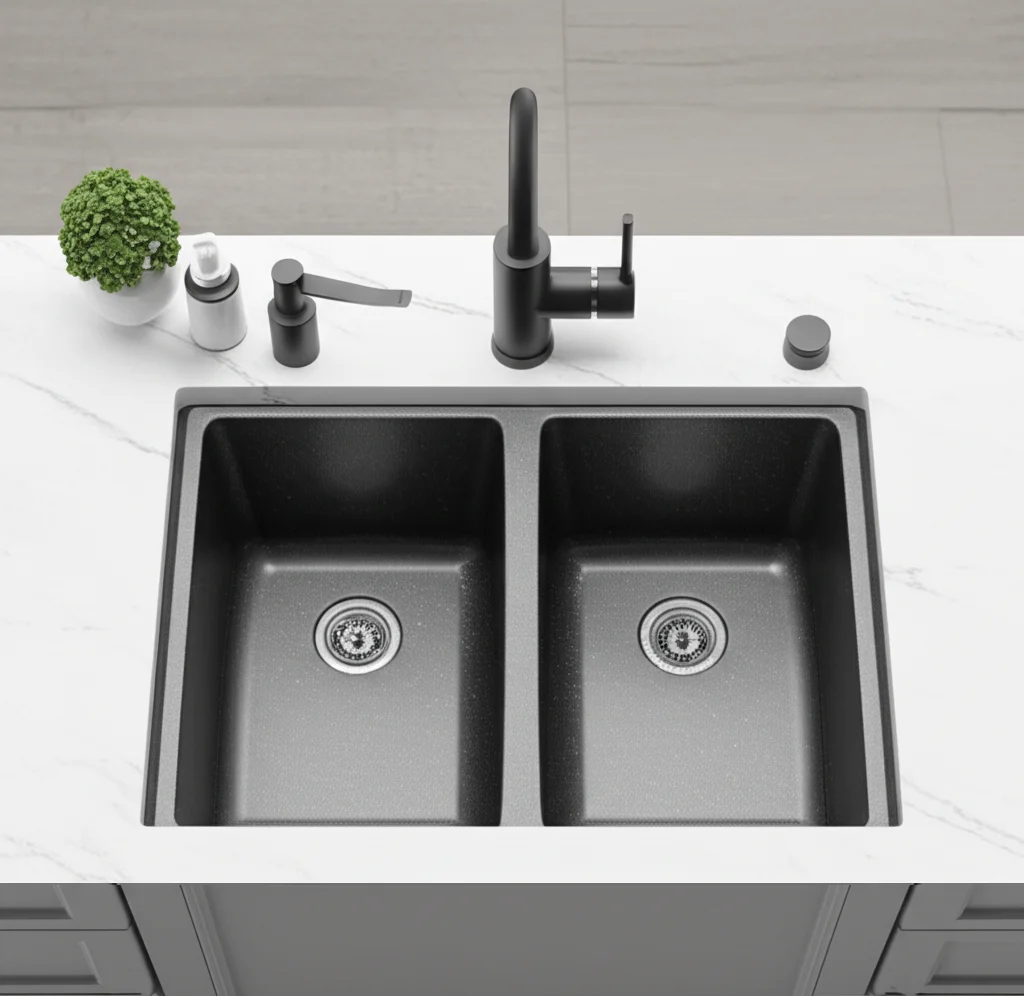· Todd Martin · Cleaning Guides · 18 min read
How To Clean Silgranit Sink

Deep Clean Your Silgranit Sink: A Complete Guide
Imagine your kitchen as the heart of your home. The sink sits at its center, witnessing countless meals and conversations. If you own a Silgranit sink, you know its beauty and durability are unmatched. But even the toughest sinks need proper care to maintain their pristine look. You might wonder, “How do I truly clean my Silgranit sink to keep it looking new?”
This guide offers a complete roadmap to effortlessly clean Silgranit sinks, ensuring they remain a stunning focal point in your kitchen. We will cover everything from daily routines to tackling stubborn stains and restoring its original luster. You will learn the best methods, essential tools, and products to use or avoid. Get ready to transform your Silgranit sink and keep it sparkling for years to come.
Takeaway
Keeping your Silgranit sink clean is simple with the right approach:
- Perform quick daily rinses and wipes to prevent buildup.
- Use mild cleaners like dish soap or vinegar for routine maintenance.
- Address specific stains promptly with appropriate non-abrasive methods.
- Avoid harsh chemicals, strong acids, or abrasive scrubbers.
- Regular deep cleaning helps maintain its look and extends its life.
To effectively clean a Silgranit sink, regularly wipe it with a soft cloth and mild dish soap to prevent daily buildup. For deeper cleaning, use a baking soda paste or a diluted white vinegar solution to remove stains and hard water spots. Always rinse thoroughly with clean water afterward to maintain its non-porous surface.
Understanding Your Silgranit Sink: What Makes It Special?
Silgranit is a unique composite material. It combines natural granite with acrylic, creating a highly durable and non-porous surface. This material is known for its resistance to scratches, heat, and impacts. Understanding its composition helps you clean your Silgranit sink correctly.
Unlike traditional cast iron or stainless steel sinks, Silgranit has a stone-like feel. Its non-porous nature makes it hygienic and easy to maintain. However, despite its toughness, using the wrong cleaning agents can damage its surface. This is why specialized cleaning methods are important for these sinks. Knowing these qualities helps you choose the best cleaning strategy.
The Benefits of Silgranit Material
Silgranit sinks offer many advantages for busy kitchens. They resist fading and staining, even from tough foods like coffee or red wine. The material also repels water and dirt, making everyday cleaning straightforward. Its robust nature means it can withstand high temperatures without damage.
Many homeowners choose Silgranit for its aesthetic appeal and practical benefits. It comes in various colors, from crisp white to deep black, fitting many kitchen designs. Proper care ensures these benefits last for decades. My own Silgranit sink has maintained its deep charcoal color for years, proving its resilience.
Why Proper Cleaning is Crucial
Regular and proper cleaning prevents grime buildup and water spots. It also helps maintain the sink’s hygienic properties. Neglecting your Silgranit sink can lead to dullness and discoloration over time. Stubborn stains become harder to remove if left untreated.
Maintaining the sink’s finish also protects its structural integrity. Using the correct products avoids scratching or chemically damaging the surface. This ensures your investment continues to look new and performs well. My neighbor once used a harsh abrasive on her dark composite sink, leading to noticeable dull spots she later regretted. For more on cleaning similar materials, you might find tips on how to clean a composite sink helpful.
Essential Daily Care for Silgranit Sinks
Daily cleaning is the first step in keeping your Silgranit sink spotless. A little effort each day prevents big problems later. This routine is simple and takes only a few minutes. Establishing a daily habit will save you time and effort in the long run.
Think of it like brushing your teeth. Small, consistent actions lead to better results. This daily care is especially important if you use your kitchen sink often. It helps maintain the sink’s shine and prevents common issues like water spots.
Simple Daily Rinse and Wipe Down
After each use, rinse your Silgranit sink thoroughly with warm water. Use a soft cloth or sponge to wipe down the entire surface. This removes food particles and liquid splashes. Pay attention to the corners and around the drain where debris can accumulate.
Drying the sink after rinsing is also important. This prevents hard water spots, especially in areas with mineral-rich water. A dry sink looks cleaner and minimizes water stain formation. I always keep a dedicated microfiber cloth near my sink for this quick daily wipe.
Using Mild Dish Soap for Everyday Grime
For light grime and greasy residue, use a few drops of mild dish soap. Apply it to a damp sponge and gently scrub the sink’s surface. Dish soap is gentle enough for daily use and effective against common kitchen messes. It cleans without stripping the sink’s protective qualities.
Rinse the sink thoroughly with clean water after scrubbing. Ensure all soap residue is washed away. Leaving soap behind can attract more dirt over time. This simple routine keeps your sink hygienic and shining.
Preventing Hard Water Spots
Hard water spots are a common issue for any sink, including Silgranit. They appear as cloudy white marks from mineral deposits. Regular drying is the best defense against these spots. Using a water softener can also help reduce mineral content.
If you notice early signs of hard water spots, a solution of equal parts white vinegar and water can help. Spray the solution on the affected areas. Let it sit for a few minutes before wiping and rinsing. For more insights on tackling similar issues, explore how to clean a sink faucet, as faucets often suffer from the same hard water buildup. Addressing these spots quickly prevents them from becoming tougher stains.
Tackling Common Stains on Silgranit
Even with daily care, tough stains can sometimes appear on your Silgranit sink. These might come from coffee, tea, red wine, or even rust. Knowing how to treat specific stains is key to restoring your sink’s appearance. Different stains require different approaches.
Acting quickly is often the most effective strategy. The longer a stain sits, the harder it can be to remove. Always test any new cleaning method in an inconspicuous area first. This prevents accidental damage to your beautiful sink surface.
Removing Food and Beverage Stains (Coffee, Tea, Wine)
Food and beverage stains are common due to daily kitchen use. For these organic stains, a baking soda paste is often very effective. Mix baking soda with a little water to form a thick paste. Apply the paste directly to the stain.
Let the paste sit on the stain for 15-30 minutes, or even longer for stubborn marks. Gently scrub with a soft brush or sponge. Rinse thoroughly with water. This method lifts many common kitchen stains without harsh chemicals.
Dealing with Tough Grease and Oil
Grease and oil stains can be tricky on any surface. For Silgranit, a degreasing dish soap works well. Apply a generous amount of concentrated dish soap directly to the oily area. Let it sit for a few minutes to break down the grease.
Scrub with a soft brush or the abrasive side of a sponge. Rinse well with hot water to wash away the dissolved grease. For extreme grease buildup in your drain, learning how to clean a clogged kitchen sink might offer additional valuable insights for a complete kitchen clean. This ensures both your sink and pipes are free from blockages.
Battling Metal Marks and Rust Stains
Metal marks from pots and pans can leave grey streaks on lighter Silgranit sinks. Rust stains come from metal objects left in the sink. For these, a non-abrasive cleaner like Bar Keepers Friend can be very effective. Sprinkle a small amount of the cleaner onto a damp sponge.
Gently rub the stained area in a circular motion. Rinse immediately and thoroughly to prevent any residue from settling. Never let Bar Keepers Friend dry on the surface. For rust stains, a lemon juice and salt paste can also work as a natural alternative.
Eradicating Hard Water and Limescale Buildup
Hard water stains and limescale are mineral deposits that dull your sink. A white vinegar solution is excellent for these. Mix equal parts white vinegar and water in a spray bottle. Spray the entire sink surface, ensuring full coverage.
Let the solution sit for 15-30 minutes. The acidity helps dissolve the mineral buildup. Scrub with a non-abrasive sponge and rinse thoroughly. For persistent hard water issues, especially on a black kitchen sink, where mineral spots might be more visible, this method is especially helpful.
Deep Cleaning and Restoring Shine to Silgranit
Beyond daily maintenance and stain removal, a periodic deep clean revitalizes your Silgranit sink. This process brings back its original luster and ensures long-term beauty. Deep cleaning helps maintain the non-porous nature of the material. It prevents dullness and keeps the sink looking new.
I find that doing a deep clean every few months makes a significant difference. It’s a satisfying process that yields immediate results. This step is key to preserving your Silgranit sink’s appearance for years.
The Baking Soda and Vinegar Method for Deep Cleaning
This classic combination offers a powerful, yet gentle, deep clean. Start by making a paste with baking soda and a little water. Spread this paste over the entire surface of your Silgranit sink. Ensure good coverage, especially on any stained or dull areas.
Let the baking soda paste sit for about 15-20 minutes. Then, spray white vinegar over the baking soda. It will fizz, creating a chemical reaction that helps lift grime and hard water deposits. Allow this mixture to work for another 5-10 minutes.
After fizzing, scrub the sink with a soft brush or sponge. Work in circular motions. Rinse the sink completely with warm water. This method leaves your sink remarkably clean and refreshed. You can even use similar vinegar methods to clean your sink drain for a truly comprehensive clean.
Using Specialist Silgranit Cleaners
Several manufacturers offer specialized cleaners designed for Silgranit and composite sinks. These products are formulated to be safe and effective for the material. They can be a good option for stubborn stains or for regular maintenance if you prefer a dedicated product. Always follow the manufacturer’s instructions carefully when using these cleaners.
Look for cleaners that specify “for granite composite sinks” or “for Silgranit.” Brands like Blanco (the maker of Silgranit) often have their own recommended cleaning agents. Using a product designed for the material ensures optimal results without damage. These cleaners often contain agents that help restore the sink’s original color and shine.
Restoring the Luster: Mineral Oil Treatment
After deep cleaning, you can enhance your Silgranit sink’s luster with mineral oil. This step is optional but highly recommended. Mineral oil helps deepen the color and adds a subtle sheen to the surface. It also creates a barrier that can repel water and stains.
Apply a small amount of food-grade mineral oil to a soft cloth. Wipe down the entire sink surface, buffing it gently. Let the oil sit for a few minutes. Then, wipe off any excess with a clean, dry cloth. Your sink will look richer and more vibrant. I do this step a couple of times a year, and it always makes my black Silgranit sink look brand new.
Preventing Future Stains and Damage
Prevention is always better than cure, especially when it comes to keeping your Silgranit sink pristine. By adopting a few simple habits, you can significantly reduce the likelihood of future stains and damage. These proactive measures help maintain your sink’s beauty with minimal effort. It is far easier to prevent a stain than to scrub one away.
Implementing these practices into your daily routine ensures long-term satisfaction. You will spend less time cleaning and more time enjoying your beautiful kitchen. My own experience has shown that these small preventative steps make a huge difference.
The Importance of Prompt Cleanup
The golden rule for preventing stains is to clean spills immediately. Whether it is coffee, wine, or cooking oil, quick action is vital. Silgranit is non-porous, but certain substances can still leave residue if allowed to dry. A quick wipe with a damp cloth can prevent most stains from setting.
Do not let food particles or liquids sit in the sink for extended periods. This is especially true for highly pigmented items. I always make sure to rinse out any tea or coffee dregs right away. This simple habit keeps the surface clear and clean.
Using Sink Grids and Protectors
Sink grids and basin protectors offer an excellent layer of defense. They sit at the bottom of the sink, creating a barrier between dishes and the Silgranit surface. This prevents scratches from pots, pans, and cutlery. They also allow water to drain freely, preventing stagnant water.
Many Silgranit sink manufacturers offer custom-fit grids. These are designed to perfectly fit your sink model. Investing in a good quality grid can prolong the life and appearance of your sink significantly. I use a grid in my own sink, and it has saved it from many potential scratches.
Avoiding Harsh Chemicals and Abrasive Tools
While Silgranit is tough, it is not immune to damage from improper cleaning agents. Harsh chemicals like strong acids, drain cleaners, or abrasive powders can etch the surface. Steel wool pads or rough scrub brushes can cause irreversible scratches. Always check the labels of cleaning products.
Stick to mild, non-abrasive cleaners specifically recommended for composite or granite sinks. Soft cloths, sponges, or nylon brushes are the safest tools to use. This protects the integrity and finish of your Silgranit. For similar reasons, when considering how to clean stainless steel, it’s important to note the proper techniques to avoid scratching that delicate finish as well.
Tools and Products to Avoid on Silgranit
Knowing what to avoid is just as important as knowing what to use. Certain cleaning products and tools can cause permanent damage to your Silgranit sink. Using the wrong items can void your sink’s warranty and compromise its durability. It is vital to protect your investment.
Always err on the side of caution. If you are unsure about a product, test it in an inconspicuous area or avoid it altogether. My experience has shown that a little caution prevents a lot of regret. This section outlines the items that pose a risk to your Silgranit sink.
The Dangers of Abrasive Cleaners and Scouring Pads
Abrasive cleaners, such as powders containing harsh grits, can scratch the non-porous surface of Silgranit. While Silgranit is scratch-resistant, it is not scratch-proof. These cleaners can dull the finish over time. Steel wool, metal scouring pads, and very stiff brushes can also leave unsightly marks.
These tools are too harsh for the smooth, composite material. They can create tiny micro-scratches that trap dirt and make the sink harder to clean in the future. Always opt for soft cloths, sponges, or nylon brushes. Protect your sink by choosing gentle cleaning accessories.
Why Harsh Acids and Alkali Cleaners are a No-Go
Strong acids (like concentrated vinegar, lemon juice, or rust removers not specified for composite sinks) and strong alkali cleaners (like ammonia-based cleaners, oven cleaners, or highly concentrated bleach) can chemically damage Silgranit. While diluted vinegar is fine for hard water, direct, undiluted application of strong acids or prolonged contact can etch the surface, leaving dull spots.
Similarly, powerful alkaline solutions can degrade the resin binder in the composite material. This leads to discoloration and surface degradation. Always use cleaners with a neutral pH or those explicitly designed for composite materials. For instance, cleaning mold under a sink might involve stronger agents, but these should never be used directly on the Silgranit surface.
Avoiding Solvent-Based Cleaners and Paint Removers
Solvent-based cleaners, such as paint thinners, nail polish removers, or industrial degreasers, are extremely harmful to Silgranit. These solvents can dissolve the acrylic resin that binds the granite particles, leading to irreversible damage. This damage often appears as dull spots, discoloration, or even softening of the material.
If you accidentally spill any of these substances, wipe them up immediately and rinse thoroughly with water. Never use them for routine cleaning. Always store these chemicals away from your sink to prevent accidental contact. Protecting your sink from such harsh chemicals is paramount for its longevity.
Troubleshooting Stubborn Issues
Even with the best preventative care, some stubborn issues might arise. These could include severe discoloration, deeply embedded stains, or minor scratches. Addressing these challenges requires a bit more effort and specialized techniques. Do not despair if your sink presents a tough problem.
Many stubborn issues can be resolved with patience and the right approach. My own sink once had a persistent tea stain that required a multi-step solution. This section will guide you through tackling those particularly tricky problems.
Tackling Persistent Discoloration
Over time, especially with lighter-colored Silgranit sinks, a general dullness or yellowing might occur. This often results from accumulated residue or hard water film. A mild bleaching agent can sometimes restore the color, but with extreme caution. Use a very dilute solution of bleach (no more than 5% bleach to water) and apply it sparingly.
Apply the diluted bleach with a soft cloth to the discolored areas. Let it sit for no more than 15-20 minutes. Rinse extremely well with clean water afterwards. Ensure no bleach residue remains. This method can be effective for white or light-colored sinks but should be avoided on dark Silgranit, as it can cause fading. For similar issues with other white surfaces, consider exploring methods for cleaning a white ceramic sink, keeping in mind material differences.
Addressing Embedded Stains
If a stain has deeply embedded itself into the surface, a poultice might be necessary. A poultice is a thick paste designed to draw out stains. You can create one using a strong absorbent material (like baking soda or talcum powder) mixed with a chemical agent (like a very diluted bleach solution or hydrogen peroxide). Form a thick paste.
Apply the poultice directly over the embedded stain, covering it with plastic wrap to keep it moist. Let it sit for several hours, or even overnight. The paste will slowly draw the stain out of the non-porous material. Scrape off the dried poultice with a plastic scraper. Rinse thoroughly. Repeat if necessary.
Repairing Minor Scratches
While Silgranit is highly scratch-resistant, hairline scratches can sometimes occur from very sharp objects or extreme impact. For minor surface scratches, a specialized Silgranit repair kit might be available from the manufacturer. These kits usually contain a fine abrasive compound and a polish.
Apply the compound with a soft cloth and gently rub the scratched area. The abrasive helps to smooth out the surface imperfections. Follow with the polish to restore the sheen. For deeper scratches, professional repair might be needed, but minor ones are often fixable. Always follow the kit’s instructions carefully.
FAQ Section
Q1: Can I use bleach on my Silgranit sink?
A1: You can use a highly diluted bleach solution on light-colored Silgranit sinks for tough stains or discoloration. Mix a maximum of 5% bleach with water. Apply it for no more than 15-20 minutes, then rinse very thoroughly. Avoid using bleach on dark Silgranit sinks, as it can cause irreversible fading or discoloration. Never use undiluted bleach.
Q2: How do I remove hard water stains from a black Silgranit sink?
A2: Hard water stains are often more visible on black Silgranit sinks. For these, a solution of equal parts white vinegar and water is highly effective. Spray the solution over the affected areas, let it sit for 15-30 minutes, then scrub gently with a soft sponge and rinse completely. Regular drying after each use also helps prevent their formation.
Q3: What is the best daily cleaner for Silgranit?
A3: For daily cleaning, plain warm water and a few drops of mild dish soap are ideal. Use a soft cloth or sponge to wipe down the sink after each use, then rinse and dry. This simple routine prevents food residue and water spots from building up, keeping your Silgranit sink looking fresh and clean with minimal effort.
Q4: Can I use abrasive sponges or scrubbers on Silgranit?
A4: No, you should avoid using abrasive sponges, steel wool, or harsh scrubbers on your Silgranit sink. While the material is durable, these tools can cause micro-scratches or dull the non-porous surface over time. Always opt for soft cloths, non-abrasive sponges, or nylon brushes to clean your Silgranit sink safely and effectively.
Q5: How often should I deep clean my Silgranit sink?
A5: The frequency of deep cleaning depends on your usage and water hardness. For average use, a deep clean every 1-3 months is generally sufficient. If you have very hard water or your sink sees heavy use, you might consider deep cleaning more often. Listen to your sink; if it looks dull or stained, it’s time for a deep clean.
Q6: Will hot pots and pans damage my Silgranit sink?
A6: Silgranit is highly resistant to heat, typically able to withstand temperatures up to 536°F (280°C). This means hot pots and pans straight from the stove or oven are generally safe to place directly into the sink. However, extreme, prolonged direct heat or sudden temperature shocks should still be avoided as a precaution for any material.
Conclusion
Cleaning your Silgranit sink does not need to be a chore. By understanding its unique properties and following a consistent care routine, you can easily maintain its beauty and durability. From daily rinses to tackling tough stains, the methods we discussed are simple yet highly effective. Remember, gentle care and prompt action are your best allies in keeping your Silgranit sink looking new.
Embrace the simple techniques like baking soda paste for stains, vinegar for hard water, and the occasional mineral oil treatment for shine. Avoid harsh chemicals and abrasive tools to protect your investment. Your Silgranit sink is a highlight of your kitchen; with proper care, it will continue to impress for many years. Now, go forth and give your Silgranit sink the brilliant clean it deserves.





